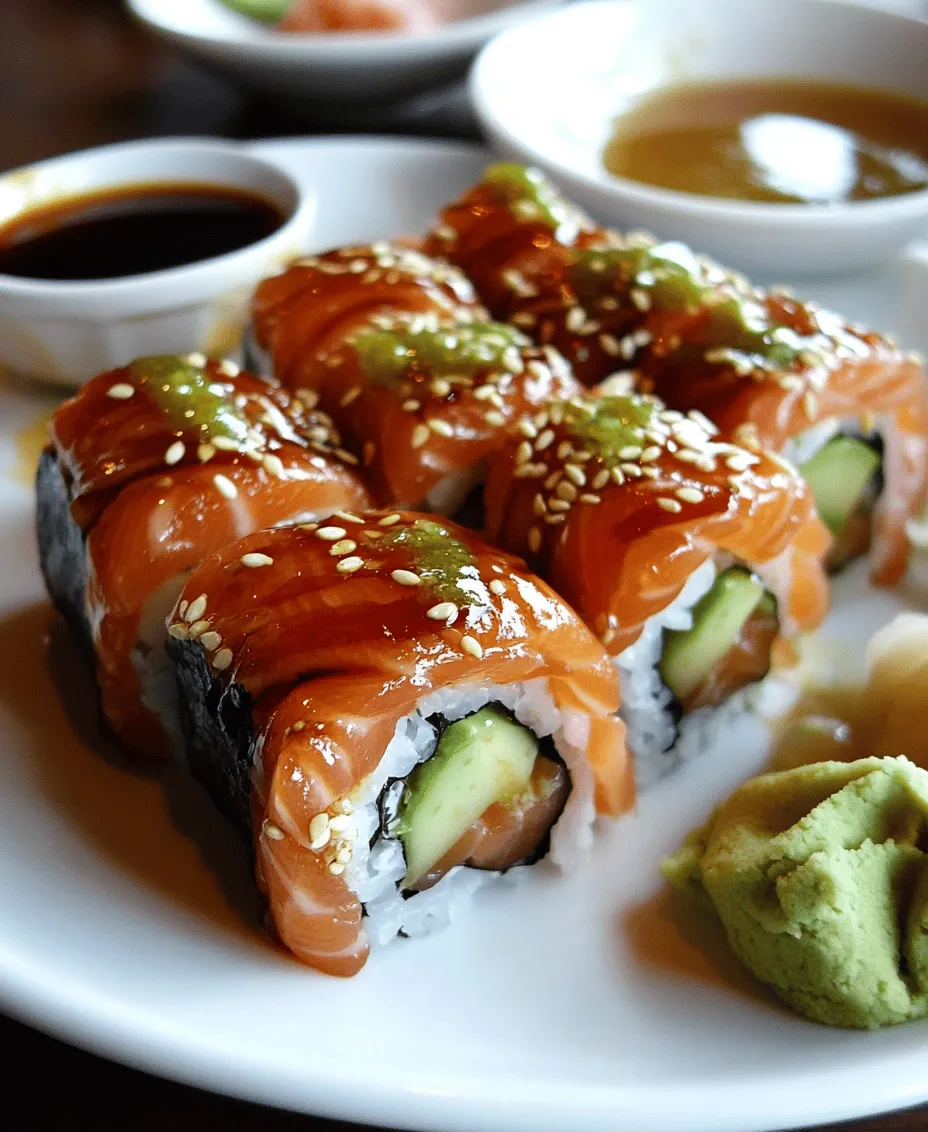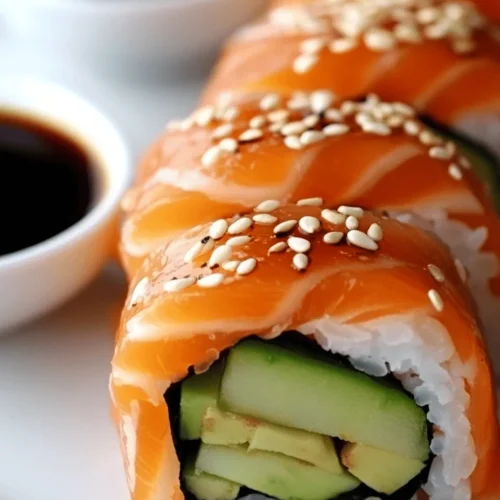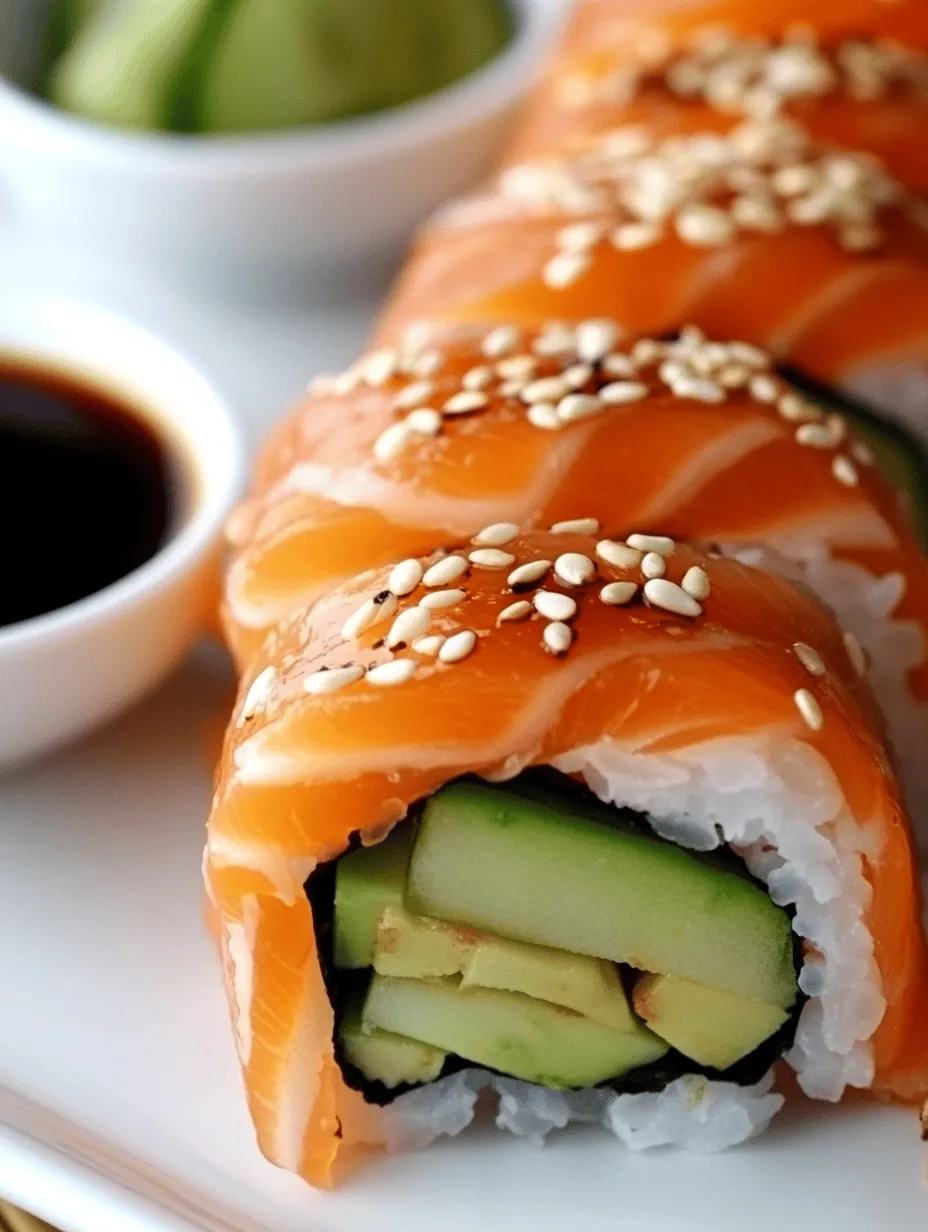When it comes to sushi, traditional practices often reign supreme, but the culinary world is always evolving. One delightful evolution of this age-old dish is Baked Salmon Sushi. This innovative take on sushi maintains the essence of Japanese cuisine while introducing a new cooking method that appeals to both sushi aficionados and those hesitant about consuming raw fish. Baked Salmon Sushi is not only a feast for the eyes but also a flavorful combination that promises to delight your palate.
In this comprehensive guide, we will take you through every step of the process of creating this delectable dish, from the essential preparation of sushi rice to the art of baking salmon and assembling your sushi rolls. Whether you are looking to impress guests at a dinner party or simply want to enjoy a cozy sushi night at home, this recipe is designed to satisfy.
Understanding the Ingredients
The Essentials of Sushi Rice
At the heart of every great sushi dish lies sushi rice. Sushi rice is unique because of its short-grain variety, which is stickier than regular rice. This stickiness is crucial for keeping the sushi rolls together, allowing for clean bites without any messy disintegration. The importance of sushi rice cannot be overstated; it is the foundation upon which the entire dish is built.
How to Select the Right Type of Rice for Sushi
For the best results, opt for high-quality short-grain rice, often labeled as “sushi rice” or “calrose rice.” These varieties have the right balance of starch, which contributes to the desired texture. Avoid long-grain rice as it does not have the same sticky quality needed for sushi preparation.
Rinsing and Cooking Sushi Rice Correctly
Preparation begins with rinsing the rice thoroughly under cold water. This step is essential to remove excess starch, which can make the rice overly sticky and gummy. Rinse the rice until the water runs clear, typically requiring several changes of water. After rinsing, the rice should be soaked for at least 30 minutes to allow it to absorb moisture evenly before cooking. Cooking sushi rice can be done in a rice cooker or on the stovetop, but it’s vital to follow the appropriate water-to-rice ratio (generally 1:1.2) for perfect results.
Fresh Salmon: The Star Ingredient
Salmon is often regarded as the star ingredient in many sushi dishes, and for good reason. Its rich flavor and buttery texture make it a favorite among seafood lovers. When preparing Baked Salmon Sushi, selecting the right salmon fillet is crucial to achieving the best flavor profile.
Benefits of Using Fresh Salmon
Fresh salmon not only enhances the taste of your sushi but also provides numerous health benefits. Salmon is rich in omega-3 fatty acids, which are essential for heart health and cognitive function. Additionally, it is an excellent source of high-quality protein and important vitamins and minerals.
How to Choose the Best Salmon Fillet
When selecting salmon, look for bright, vibrant colors—ranging from deep orange to pink—indicating freshness. The flesh should be firm to the touch and have a mild, clean smell reminiscent of the sea. Wild-caught salmon is often considered superior in flavor and nutritional value, but high-quality farmed salmon can also be a good choice.
The Role of Baking in Enhancing Flavors and Texture
Baking salmon not only ensures that it is fully cooked, making it safe to eat, but also enhances its natural flavors. The gentle heat of the oven allows the fish to retain moisture, resulting in tender, flaky pieces that complement the sushi rolls beautifully. Baking also provides an opportunity to season the salmon with various spices and marinades, elevating the overall dish.
Complementary Ingredients
While the sushi rice and salmon take center stage, complementary ingredients play a significant role in creating the perfect Baked Salmon Sushi.
Overview of Additional Ingredients: Avocado, Cucumber, Nori
To create a balanced flavor profile, consider adding fresh ingredients such as avocado and cucumber. Avocado contributes a creamy texture, while cucumber adds a refreshing crunch. Both ingredients work well together, enhancing the overall experience of the sushi. Nori, the seaweed sheet used to wrap the sushi, is not only a traditional element but also adds a depth of flavor that pairs well with the other ingredients.
The Significance of Rice Vinegar, Sugar, and Salt in Sushi
Seasoning the sushi rice is crucial for achieving the right taste. The combination of rice vinegar, sugar, and salt creates a perfect balance that enhances the flavor of the rice. Rice vinegar adds a tangy note, sugar provides a subtle sweetness, and salt brings all the flavors together. It’s important to fold the seasoning into the rice gently to avoid breaking the grains.
Exploring the Flavors of Soy Sauce, Honey, and Sesame Oil
When it comes to dipping sauces or drizzling over your sushi, soy sauce is a classic choice that adds umami depth. For a creative twist, consider mixing soy sauce with a touch of honey for sweetness and sesame oil for nuttiness. This combination not only enhances the flavor of the salmon but also ties all the elements of the dish together beautifully.
Step-by-Step Guide to Making Baked Salmon Sushi
Now that we have an understanding of the essential ingredients, let’s delve into the step-by-step process of making Baked Salmon Sushi.
Preparing the Sushi Rice
1. Rinse the Rice: Start by measuring the desired amount of sushi rice—typically, one cup serves about two people. Place the rice in a fine-mesh sieve and rinse under cold water until the water runs clear. This step is crucial for removing excess starch and preventing gummy rice.
2. Soak the Rice: After rinsing, transfer the rice to a bowl and cover it with fresh cold water. Allow the rice to soak for at least 30 minutes. Soaking helps achieve the perfect texture during cooking.
3. Cook the Rice: Drain the soaked rice and transfer it to a rice cooker. For stovetop cooking, combine the rice with water in a pot using the recommended water-to-rice ratio. Bring it to a boil, then reduce the heat to low, cover, and simmer for about 15 minutes or until the water is absorbed. Allow the rice to sit covered for another 10 minutes off the heat to steam.
4. Season the Rice: While the rice is still warm, transfer it to a large bowl. In a separate bowl, mix rice vinegar, sugar, and salt until dissolved. Gently fold this seasoning into the rice using a wooden spatula or rice paddle, being careful not to mash the grains. Allow the seasoned rice to cool to room temperature before assembling your sushi.
Baking the Salmon to Perfection
1. Preheat the Oven: Preheat your oven to 375°F (190°C).
2. Prepare the Salmon: While the oven is heating, place the salmon fillet on a baking sheet lined with parchment paper. Brush the fillet with a mixture of soy sauce, honey, and sesame oil for added flavor. Season with salt and pepper to taste.
3. Bake the Salmon: Place the salmon in the preheated oven and bake for approximately 15-20 minutes or until the fish flakes easily with a fork. The internal temperature should reach 145°F (63°C) for safe consumption. Keep an eye on the salmon to prevent overcooking, which can dry it out.
Assembling Your Sushi Rolls
Once your sushi rice is seasoned and the salmon is baked to perfection, it’s time to assemble your sushi rolls. This process is where the fun really begins! Using a bamboo sushi mat, you can create perfect rolls that are visually appealing and delicious.
1. Prepare the Sushi Mat: Lay a bamboo sushi mat on a clean, flat surface. Place a sheet of nori on top, shiny side down.
2. Spread the Rice: Wet your hands to prevent sticking and grab a handful of sushi rice. Spread the rice evenly over the nori, leaving about an inch of space at the top to seal the roll later.
3. Add Fillings: Layer thin slices of baked salmon, avocado, and cucumber horizontally across the rice.
4. Roll the Sushi: Starting from the bottom, use the bamboo mat to carefully roll the sushi away from you, pressing gently but firmly to keep the roll tight. Continue rolling until you reach the exposed edge of the nori.
5. Seal the Roll: To seal the sushi roll, dampen the exposed edge of the nori with a little water. Press to seal the roll securely.
6. Slice and Serve: Use a sharp knife to slice the roll into bite-sized pieces, cleaning the knife between cuts to ensure clean edges. Serve with additional soy sauce, pickled ginger, and wasabi for an authentic experience.
This delicious Baked Salmon Sushi is ready to be enjoyed! With its combination of flavors and textures, it’s sure to be a hit at any gathering or a special treat for a night in. The next part of this guide will delve deeper into tips for perfecting your sushi-making skills and answering some common questions about this delightful dish.

Tips for Spreading Rice Evenly and Adding Fillings
When making Baked Salmon Sushi, achieving the right texture and distribution of rice is crucial for a successful roll. Here are some tips for spreading your sushi rice evenly and adding fillings effectively:
– Use Wet Hands: Before you start handling the sushi rice, wet your hands with water to prevent sticking. This simple step will make it easier to spread the rice without it clumping together.
– Even Layering: Use a spatula or your fingers to distribute the sushi rice evenly over the nori. Aim for about a ¼-inch thick layer of rice. Make sure to leave about 1 to 1.5 inches of space at the top edge of the nori (the side that will be rolled last) to ensure proper sealing.
– Strategic Filling Placement: When adding fillings like baked salmon, avocado, or cucumber, place them in a line across the center of the rice. Avoid overfilling, as this can lead to messy rolls. A simple rule is to use about 1 to 2 tablespoons of filling per roll.
– Pressing Down: Gently press down the rice and fillings with your fingers to ensure they adhere to one another. This helps to create a cohesive roll that won’t fall apart.
Techniques for Rolling Sushi Tightly and Effectively
Rolling sushi can seem daunting at first, but with practice and the right technique, you can master this skill. Here’s how to roll your Baked Salmon Sushi tightly and effectively:
– Start from the Bottom: Position the bamboo mat in front of you with the nori sheet facing up. Begin rolling from the edge closest to you, lifting the mat and rolling it over the filling.
– Use Pressure: As you roll, apply gentle but firm pressure to shape the sushi. Your goal is to tuck the nori over the fillings and rice, creating a tight cylinder without squishing the ingredients.
– Finish the Roll: Once you’ve reached the exposed edge of the nori, moisten it with a little water to help seal the roll. Ensure the seam side is down when you place the roll on the cutting board.
– Let it Rest: After rolling, let the sushi rest for a few minutes before cutting. This helps the roll hold its shape better.
Presentation and Garnishing
Cutting the Rolls
The way you cut your sushi rolls can greatly impact their presentation. Here are best practices for slicing your Baked Salmon Sushi:
– Sharp Knife: Use a sharp, non-serrated knife to make clean cuts. A dull knife can crush the roll, ruining its appearance.
– Wet the Blade: Dip the knife in water before each cut to prevent sticking. This will ensure a smooth cut through the rice and nori.
– Cutting Technique: Slice the roll into 6 to 8 pieces, depending on your preference. Cut with a gentle sawing motion rather than pressing down, which helps maintain the integrity of the roll.
Garnishing Your Sushi
Garnishing enhances the visual appeal of your sushi and adds complementary flavors:
– Sesame Seeds: Sprinkle toasted sesame seeds over the top of the sushi rolls for a nutty flavor and a delightful crunch. This simple touch can elevate the presentation significantly.
– Herbs and Greens: Consider adding fresh herbs like cilantro or shiso leaves for an aromatic touch. Placing these alongside the sushi adds color and freshness.
– Serving Sauces: Serve your Baked Salmon Sushi with traditional accompaniments like soy sauce, pickled ginger, and wasabi. These not only enhance the taste but also offer a beautiful contrast against the sushi.
Nutritional Value and Health Benefits
Nutritional Breakdown of Baked Salmon Sushi
Understanding the nutritional value of your food can enhance your culinary experience. Here’s a breakdown of the calories and macronutrients per serving of Baked Salmon Sushi:
– Calories: Each serving of Baked Salmon Sushi typically contains around 250-300 calories, depending on the portion size and ingredients used.
– Macronutrients: On average, each serving includes:
– Protein: 12-15 grams
– Carbohydrates: 30-35 grams
– Fats: 8-10 grams (largely healthy fats from salmon)
– Vitamins and Minerals: Salmon is rich in omega-3 fatty acids, which are beneficial for heart health, along with vitamins B12, D, and selenium. The use of fresh vegetables like avocado and cucumber adds fiber, vitamins, and minerals.
The Role of Sushi in a Balanced Diet
Incorporating sushi into your diet can offer numerous health benefits:
– Lean Protein Source: Salmon is an excellent source of high-quality protein, essential for muscle repair and growth.
– Nutrient-Dense Ingredients: Sushi often includes a variety of vegetables and healthy fats, making it a nutrient-dense choice.
– Portion Control: Sushi rolls can be made to suit individual preferences, allowing for customization in portion size and ingredients.
– Culinary Variety: Enjoying sushi can introduce new flavors and textures to your meals, making healthy eating more enjoyable.
However, it’s important to be mindful of the sodium content in soy sauce and the potential for added sugars in some sushi rice preparations.
Common Mistakes to Avoid
Troubleshooting Sushi Rice
Sushi rice is a fundamental element of great sushi. Here are common issues and solutions:
– Too Sticky or Too Dry: If your sushi rice is too sticky, it may have been overcooked or too much water was used. For dry rice, ensure you’re using the right water-to-rice ratio (typically 1:1.2 for sushi rice) and allow it to cool properly before using.
– Not Seasoning Properly: Sushi rice should be seasoned with a mixture of rice vinegar, sugar, and salt. Make sure to mix it gently to avoid crushing the grains.
Avoiding Sushi Assembly Errors
When assembling your sushi rolls, keep these potential pitfalls in mind:
– Overfilling: Adding too much filling can cause your sushi rolls to burst. Stick to the recommended amount for a secure roll.
– Not Rolling Tightly Enough: If rolls are not tightly packed, they can fall apart when sliced. Use consistent pressure while rolling to ensure a firm structure.
– Cutting Too Soon: Allowing the roll to rest before slicing helps it maintain its shape. Cutting too soon can lead to a messy presentation.
Conclusion
Baked Salmon Sushi is not only a delicious dish but also an accessible way to enjoy the art of sushi-making at home. With the right ingredients and our detailed guidance, you can create a stunning and flavorful meal that is sure to impress. Whether it’s a casual weeknight dinner or a festive gathering, this recipe offers a unique culinary experience that combines simplicity with sophistication. Embrace the flavors of sushi with this delightful baked variation and discover the joy of homemade sushi.
With the tips and techniques provided, you’ll be well on your way to mastering sushi-making. From perfecting your rice to rolling with confidence, each step is part of a rewarding process that culminates in beautiful, tasty sushi. So gather your ingredients, invite friends or family to join in the fun, and enjoy the delicious experience of creating Baked Salmon Sushi at home.


